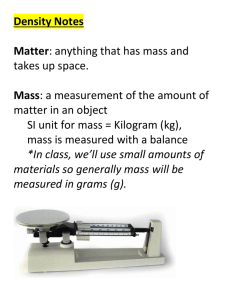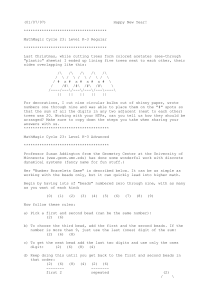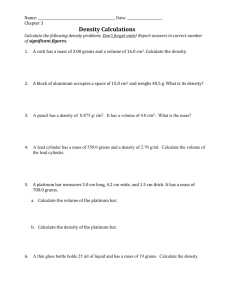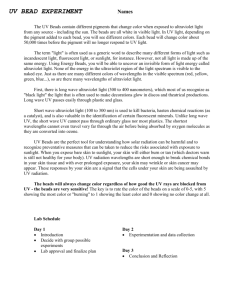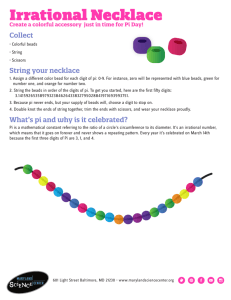Density g/ml - Spokane Falls Community College!
advertisement
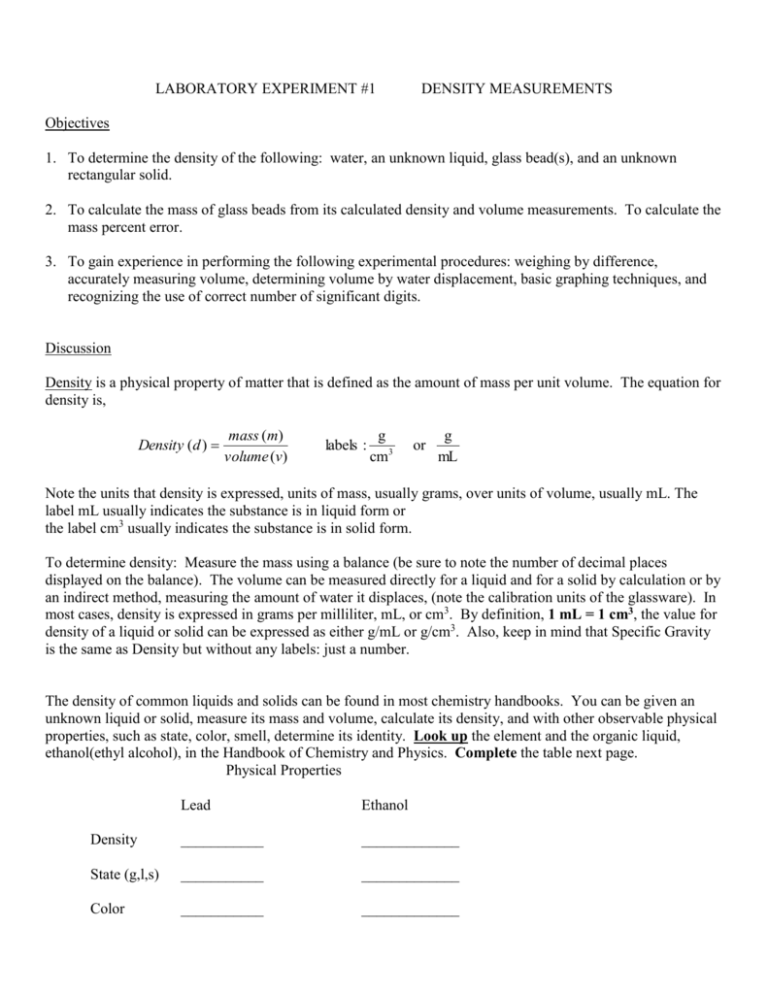
LABORATORY EXPERIMENT #1 DENSITY MEASUREMENTS Objectives 1. To determine the density of the following: water, an unknown liquid, glass bead(s), and an unknown rectangular solid. 2. To calculate the mass of glass beads from its calculated density and volume measurements. To calculate the mass percent error. 3. To gain experience in performing the following experimental procedures: weighing by difference, accurately measuring volume, determining volume by water displacement, basic graphing techniques, and recognizing the use of correct number of significant digits. Discussion Density is a physical property of matter that is defined as the amount of mass per unit volume. The equation for density is, Density (d ) mass (m) volume (v) labels : g cm3 or g mL Note the units that density is expressed, units of mass, usually grams, over units of volume, usually mL. The label mL usually indicates the substance is in liquid form or the label cm3 usually indicates the substance is in solid form. To determine density: Measure the mass using a balance (be sure to note the number of decimal places displayed on the balance). The volume can be measured directly for a liquid and for a solid by calculation or by an indirect method, measuring the amount of water it displaces, (note the calibration units of the glassware). In most cases, density is expressed in grams per milliliter, mL, or cm3. By definition, 1 mL = 1 cm3, the value for density of a liquid or solid can be expressed as either g/mL or g/cm3. Also, keep in mind that Specific Gravity is the same as Density but without any labels: just a number. The density of common liquids and solids can be found in most chemistry handbooks. You can be given an unknown liquid or solid, measure its mass and volume, calculate its density, and with other observable physical properties, such as state, color, smell, determine its identity. Look up the element and the organic liquid, ethanol(ethyl alcohol), in the Handbook of Chemistry and Physics. Complete the table next page. Physical Properties Lead Ethanol Density ___________ _____________ State (g,l,s) ___________ _____________ Color ___________ _____________ After performing the experimental techniques in this lab, you will be able to come close to identifying relatively pure unknown solids and liquids. Table 1 Properties of Unknown Liquids Density g/ml Color Smell Ethanol 0.789 clear alcohol, medicinal 25% Magnesium Chloride Solution 0.123 clear no odor 1.11 clear no odor 1.00 clear Ethylene glycol (antifreeze) Water no odor Table 2 Properties of Unknown Solids Density g/cm3 Color Appearance (sugar) 1.59 white crystalline solid Glass (borosilicate) 2.40 clear smooth solid Copper 8.94 orange metallic Aluminum 2.70 shinny smooth solid Acrylic 1.18 clear smooth solid Nylon 1.22 white smooth solid Steel, Iron 7.87 shinny smooth solid PVC 1.62 Dark grey smooth solid Sucrose Procedure A. Density of Water 1. Weigh a 125 mL Erlenmeyer flask. Record the initial mass (empty flask) with the appropriate number of decimal places on the data sheet. Obtain a new initial mass when you begin your Run 2. 2. Measure between 15.0 mL to 25.0 mL of water in a 50 mL graduated cylinder. Measure very accurately, record the actual volume used to the appropriate number of decimal places on the data sheet. 3. Pour the contents into the weighed Erlenmeyer flask. Reweigh the flask. Record the final mass (flask + water) on the data sheet. 4. Subtract the initial weight from the final weight to determine the mass of the water used and record on the data sheet. 5. Determine the density of the water by dividing the mass by the volume. The density of water is 1.000 g/mL. Your result should be within 0.05 g/mL. Record your density value on the data sheet. Repeat the same procedures, filling in the data in Run 2 column. Be very accurate with the volume measurement and recording weight precisely. 7. Average the two (2) density values. Report the density on the data sheet with proper significant figures. B. Density of an Unknown Liquid 1. Obtain about 15 mL of an unknown liquid and place in a container. Record the unknown number on the data sheet. 2. Weigh a 125 mL Erlenmeyer flask. Record the initial mass with the appropriate number of decimal places on the data sheet. 3. Accurately measure, as close as possible, 10.0 mL of the liquid using a graduated cylinder. Record the actual volume of liquid used with the appropriate number of digits on the data sheet. Pour the contents from the cylinder into the weighed flask. 4. Reweigh the flask. Record the final mass on the data sheet. 5. Subtract the initial weight (empty flask) from the final weight to determine the mass of the unknown liquid used and record on the data sheet. 6. Calculate the density of the unknown by dividing the mass by the volume. Record the density value on the data sheet. 7. Repeat the procedure for Run 2; record the data in the column for Run 2. 8. Calculate the density of your unknown liquid from both Runs. Average the two results. Be careful to report density with proper significant figures. 9. Refer to Tables 1 to identify your unknown and record on the data sheet. C. Density and Mass Calculations of Glass Bead(s) Graphing Exercise Using Glass Beads 1. Obtain and weigh 20 glass beads, record the mass on the data sheet. Pick out a single bead, weigh this bead, and record its mass on the data sheet. 2. Obtain a 10.00 mL graduated cylinder. Fill the cylinder between 5.00 to 6.00 mL of water. Observe the bottom of the meniscus and estimate the water level. Be sure to use the appropriate number of significant digits (2 dec.mal places) from the graduated cylinder. Record this value (Water Level) in the data chart corresponding to “zero” beads. 3. Place the glass bead you weighed into the graduated cylinder. Carefully observe and estimate the water level. Record the water level value in the data chart corresponding to one (1) bead. 4. Now, place a second bead in the cylinder. Observe and record the water level in the chart corresponding to 2 beads. 5. Now place 3 more beads (total 5 beads) into the cylinder. Observe and record the water level in the chart corresponding to 5 beads. Repeat this procedure for each total count of beads as indicated on the data chart: 9 total beads, 15 total beads, and 20 total beads. 6. Calculate Density, subtract Water Level (1 bead) from Water Level (0 beads).The difference between these two values is the amount of water that was displaced by the glass bead, or in other words, is the volume of the glass bead itself. Record this value. Repeat this procedure for 20 glass beads. 7. Calculate the density of glass beads by dividing the mass by the volume. Record the density value on the data sheet. density glass bead = mass of bead (g) / volume of water displaced (mL) 8. Prepare the graph: horizontal (X-axis) label Number of Beads vertical (Y-axis) label Water Level Calibrate the Y-axis, the first line, mark as 5.0 mL. Mark each line in 0.5 increments. The top line on the Y-axis will represent 10.0 mL. 9. Plot the data points on the graph and draw a straight line that best represents the data. D. Density Unknown Solid – part 1 Finding Percent Error in Calculations – part 2 Part 1 1. Obtain an unknown solid and record the unknown number on the data sheet. 2. Weigh the unknown solid. Record the mass on the data sheet. 3. Measure the length, width, and thickness in cm. Remember to include the estimated digit. Record the measurements on the data sheet. 4. Calculate the volume of the solid. Volume (cm3) = length x width x thickness 5. Calculate the density of the solid. 6. Average your two Density values. Refer to Table 2. Identify and record your unknown solid. Part 2 Now, you will calculate the Percent Error for your unknown solid. The formula for Percent Error is below. Equation : Percent Error = average density of unknown - density from table 2 density ta ble 2 100 1. Refer to Table 2. Find the density of the unknown you have identified. Place this value in the denominator in the equation above. 2. Place the average density you calculated for your unkown in the numerator. Calculate and record Percent Error on the data table. E. Calculating Volume & Thickness of Foil 1. Obtain a piece of foil. Record the type of foil you used: copper or aluminum 2. Weigh the foil and record the mass on the data sheet. 3. Measure the length and width of the foil, in cm, record on the data sheet. 4. Calculate the volume of foil Remember: density = mass/volume. Refer to table 2 to find the density for the type of foil you are using. mass foil Therefore, Volume foil density foil 5. Calculate the thickness of foil We now have a value for volume. Volume = length x width x thickness We have already measured length and width, so plug in the numbers to determine thickness. Report the number in proper significant figures on the data sheet. Thickness (cm) Volume (cm3 ) length x w idth (cm 2 ) Name_______________________________ Chem. 161 Fall ’13 Lab #1 Score: ____ Data Sheet A. Density of Water Run 1 Run 2 mass of flask + water _______________grams _________________grams (final) (final) mass of empty flask ________________grams _________________grams (intial) (intial) mass of water _____________________grams _________________grams volume of water ____________________mL _________________mL Show your calculations for density of water for Run 1 & Run 2. Density of water ________________g/mL Average Density of water __________________g/mL ________________g/mL B. Density of Unknown Liquid Unknown number_____ Run 1 mass of flask + liquid _______________grams (final) mass of empty flask ________________grams (intial) Run 2 ___________________grams (final) ___________________grams (intial) mass of unknown liquid _____________grams ___________________grams volume of unknown liquid ___________mL ___________________mL Show your calculations for density of unknown liquid, Run 1 & Run 2. Record answers at the top of the next page. Density of unknown liquid ______________g/mL ___________________g/mL Average density of unknown liquid _________________g/mL Identity of unknown liquid__________________________________ C. Glass Bead(s) use 10.00-mL graduated cylinder to recorder water level to 2 decimal places mass 1 glass bead ____________grams __________grams 10.00 Volume (mL) Number Water of Beads Level 0 1 2 5 9 14 20 mass 20 glass beads 5.00 0 5 10 15 Number of Beads 20 Show your calculations for density for 1 glass bead and 20 glass beads Water level 1 beads ___________ mL Water level 20 beads __________ mL Water level 0 bead ____________ mL Water level 0 bead ___________ mL Volume of 1 bead ____________ mL Volume of 20 beads __________ mL Density of 1 bead _____________g/mL Density of 20 beads ____________g/mL D. Calculation for Unknown Solid Unknown Number: _____ mass of solid ______________grams length of solid _______________ cm width of solid ______________cm thickness of solid_____________cm Show your calculations for the volume of the solid Volume of solid ___________________ cm3 Show your calculations for density of the solid Density of the solid __________ g/cm3 Calculations for Percent Error Percent Error: _______________ Identity of unknown solid_______________ E. Calculation for Metallic Foil Type of foil: _________ mass of foil _____________________grams length of foil _______________ cm width of foil ________________ cm Show your calculations for volume of foil. Volume of foil _____________________________ cm3 Show your calculations for thickness of foil Thickness of foil ___________________cm Conclusion 1. The mass values obtained from the balance you record, will have _____ decimal places. 2. The 10-mL graduated cylinder can be estimated and recorded with _____ decimal places, and the 25, 50 or 100-mL cylinders will have _____ decimal places. 3. The measured lengths you obtain from the scale (ruler) will be estimated and recorded with ____ decimal places. ADDITIONAL PROBLEMS PART I. Conversions Problems. Be sure to show your steps for full credit. 1. 50 cm to ____________ mm 2. 25 mg to ____________ cg 3. 89 cg to ___________ g 5. 3.88*104 km to _______________ cm 4. 0.0489 L to ____________ mL -16 8. 3.4 *10 kL to _____________ L PART II. Carry out each of the indicated operations, round to 4 significant figures and write your answers in proper scientific notation form 1. 75,000 * 800,000 * 0.000000045 = 66,500 * 85,000 2. 0.0045 * 78,000 *132,000,000,000 = 0.000555 * 0.00155 * 82,500,000 PART III. Density problems 1. The density of sulfuric acid is 1.894 g/cm3. What is the mass of 75.0 mL of sulfuric acid? 2. The density of alcohol is 0.78945 g/cm3. What volume would be required to obtain 100.0 g of alcohol? 3. What volume would be occupied if air has a density of 1.19 g/L and a mass of 362.3 grams?

